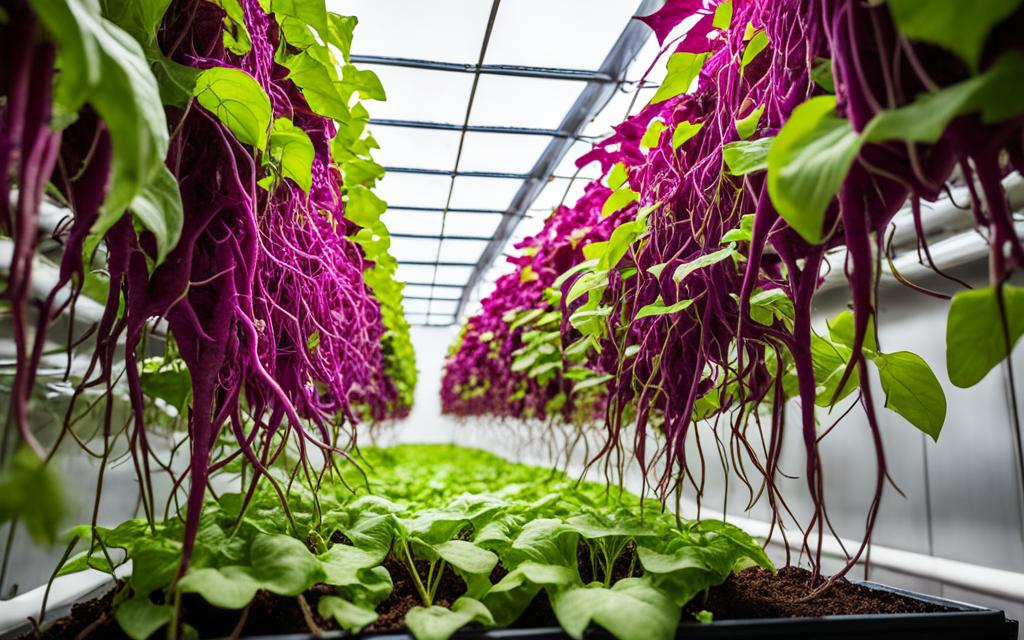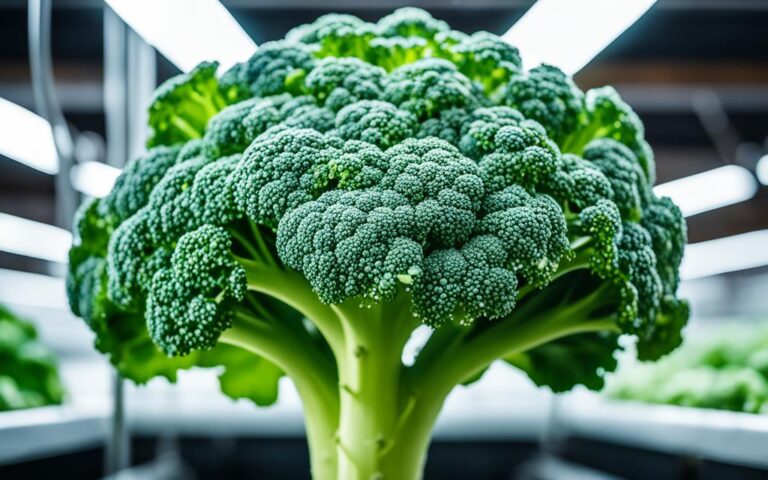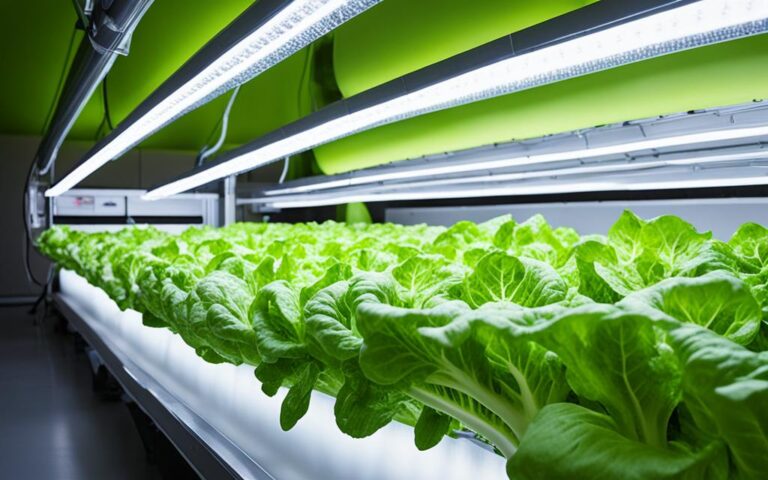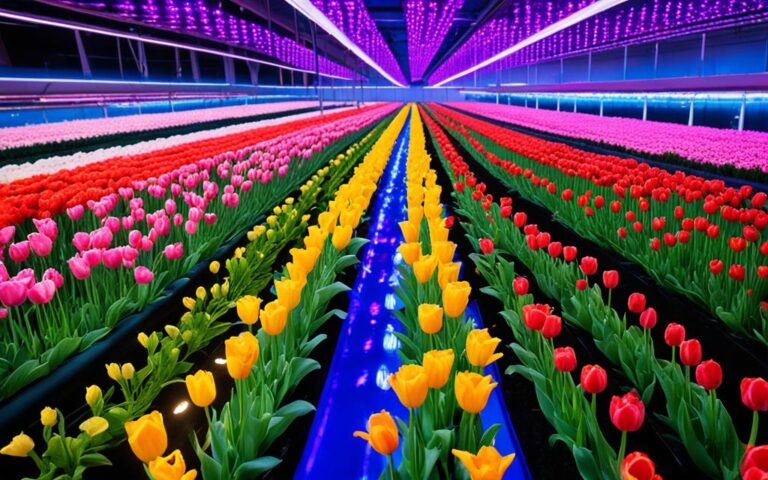Hydroponic Sweet Potatoes: Grow Tips & Benefits
Did you know hydroponic sweet potatoes can produce up to 50% more than traditional farming? This new way of growing sweet potatoes brings many benefits. It ensures a steady supply all year and boosts their nutritional value. This guide is perfect for both seasoned hydroponic gardeners and beginners. It will teach you how to grow healthy hydroponic sweet potatoes at home or in a business.
Key Takeaways
- Hydroponic sweet potato cultivation can increase yields by up to 50% compared to traditional soil-based methods.
- Hydroponic systems allow for year-round production and reduced pest and disease concerns.
- Optimal growing conditions, nutrient solutions, and planting techniques are essential for successful hydroponic sweet potato cultivation.
- Hydroponic sweet potatoes offer a range of nutritional benefits, including high levels of vitamins A and C, and minerals.
- Properly harvesting and curing hydroponic sweet potatoes is crucial for maximizing storage life and flavor.
Introduction to Hydroponic Sweet Potatoes
Sweet potatoes, known as Ipomoea batatas, are a tasty and healthy root vegetable. They belong to the morning glory family, not the potato family. These roots are sweet and come in colors like orange, white, yellow, and purple.
What are Sweet Potatoes?
Sweet potatoes are not true tubers but tuberous roots. They’ve been grown for over 5,000 years in the Americas. Now, they’re a key food in many places around the world.
Benefits of Growing Hydroponic Sweet Potatoes
Hydroponic sweet potatoes have big advantages over growing them in soil. They can be grown all year, not just during certain seasons. They’re also protected from pests and diseases that can harm soil plants.
This method lets growers create the perfect conditions for bigger, healthier sweet potatoes. Plus, hydroponic systems are great for any size of farm or garden. They’re perfect for both small and large growers.
| Advantages of Hydroponic Sweet Potatoes | Advantages of Soil-Based Sweet Potatoes |
|---|---|
|
|

“Hydroponic systems offer a controlled environment that can significantly boost sweet potato yields and quality, making them a viable option for both small-scale and large-scale growers.”
Setting Up a Hydroponic System
Growing hydroponic sweet potatoes is popular with two main systems: Deep Water Culture (DWC) and Nutrient Film Technique (NFT). The choice between these best hydroponic system for sweet potatoes depends on space, scale, and personal preference.
Choosing the Right Hydroponic System
The DWC system is simple, with a container for plants and a reservoir for nutrients. The NFT system uses a channel for nutrients and grow tubes or baskets for plants. Both types of hydroponic systems for sweet potatoes have benefits and can be customized for growers.
Essential Components for a Hydroponic Setup
For a successful hydroponic sweet potato setup, you need certain key items. These include:
- A growing container or channel
- A reservoir for the nutrient solution
- A submersible pump to circulate the solution
- A growing medium such as coco coir, perlite, or LECA (Lightweight Expanded Clay Aggregate)
Growers must also keep an eye on the nutrient solution’s pH and EC. Plus, they need good what do you need for a hydroponic sweet potato system lighting and temperature control for sweet potatoes.
“Setting up the right hydroponic system is crucial for growing healthy and bountiful sweet potato crops.”
Starting Your Hydroponic Sweet Potato Crop
Growing sweet potatoes hydroponically offers several ways to start your crop. You can use slips, chitted potatoes, or store-bought organic sweet potatoes. Each method has its own benefits and things to consider.
Growing from Slips
Starting with sweet potato slips is a popular choice. These are the sprouts that grow from a mature sweet potato. Put a sweet potato in water to let the sprouts develop roots.
Once the slips have strong roots, you can move them to your hydroponic containers. Or, start them in a Rockwool cube to help their roots grow more.
Growing from Chitted Potatoes
Using chitted potatoes is another way to grow your sweet potatoes. Chitting means letting the potato sprout before planting. Keep the potatoes in a warm, moist spot until sprouts appear.
Then, plant these chitted potatoes in your hydroponic system. You can let all sprouts grow for smaller tubers or trim to three for bigger ones.
Growing from Organic Sweet Potatoes
Starting with organic, untreated sweet potatoes from the store is easy. Just plant them directly in your hydroponic setup. They will sprout naturally once in the growing medium.
Choosing how to start your sweet potato crop affects your success. Knowing the different options helps you set up your hydroponic garden well.
Optimizing Growing Conditions
Getting the right growing conditions is key for growing lots of healthy hydroponic sweet potatoes. You need to think about temperature and lighting.
Temperature Requirements
Sweet potatoes love warm, tropical places. They do best in a temperature range of 65°F to 75°F. It’s important to keep the temperature right, as they don’t grow well in cold.
Growers might need to use heating or cooling systems to keep the ideal temperature for hydroponic sweet potatoes steady. This is especially true in places with big temperature changes or extreme seasons.
Lighting Requirements
Sweet potatoes need a lot of light to grow big and produce well. They should get 10 to 12 hours of direct sunlight or full-spectrum grow lights daily. If you’re growing them indoors with hydroponics, make sure they have enough artificial lighting.
This could be from LED or high-intensity discharge (HID) lamps. It’s important to give them the light they need hydroponics to grow well.
By managing the temperature and lighting conditions well, growers can make a great environment for their hydroponic sweet potatoes. This helps them grow to their best.
Nutrient Solution and pH Levels
Keeping the right hydroponic sweet potato nutrient solution and pH levels is key for a successful hydroponic sweet potato system. Sweet potatoes do best in a solution with a pH of 5.8 to 6.2. This ensures they get the nutrients they need. The solution should also have a parts per million (ppm) of 1400 to 1700.
Growers should check and tweak the ideal pH for hydroponic sweet potatoes often. This keeps the plants healthy and helps them grow strong. You can use a handheld pH meter or test strips for this. To adjust the pH, add pH up or pH down solutions to the nutrient water.
- Keep the pH between 5.8 and 6.2 for best nutrient uptake.
- Target a nutrient solution with a ppm of 1400 to 1700.
- Check and adjust the pH and nutrient levels often to keep plants thriving.
“Proper nutrient management is the key to growing healthy and productive hydroponic sweet potatoes.”
By keeping a close eye on the hydroponic sweet potato nutrient solution and ideal pH for hydroponic sweet potatoes, growers can help their sweet potato crops reach their best.
Planting and Spacing
Growing hydroponic sweet potatoes requires careful attention to depth and container size. These factors greatly affect the plant’s growth and yield. Sweet potato roots need enough space to spread and grow well. So, choosing the right planting depth and container size is key.
Depth to Plant Hydroponic Sweet Potatoes
Sweet potato slips or chits should be planted at least 9 inches deep. This lets the roots grow fully. You can go up to 24 inches deep, depending on your container size.
Container Size for Hydroponic Sweet Potatoes
The container must be deep enough for the roots to grow. Aim for a depth of 9 inches, but 12 to 18 inches is better. Also, keep plants 4 to 6 inches apart to let them spread out and thrive.
| Planting Depth | Container Depth | Plant Spacing |
|---|---|---|
| 9-24 inches | 12-18 inches | 4-6 inches |
Follow these guidelines for depth and spacing to support your hydroponic sweet potatoes. This will help them grow healthy and produce a great harvest.
Hydroponic Sweet Potato Growth Stages
Growing hydroponic sweet potatoes takes you on a journey through several growth stages. Knowing these stages is key to a great harvest and making the best conditions for your sweet potatoes.
The first stage is the sprouting and rooting phase. Here, the tubers or slips sprout and grow strong roots. This is vital for the plant’s growth later on.
Then, the vegetative growth stage begins. During this, the plants grow lots of leaves and vines. This shows how healthy the plant is and prepares it for growing the underground roots we love.
- Tuber Initiation and Enlargement: The tuber initiation and enlargement stage is where the magic is. Here, the sweet potatoes start to form and get bigger, becoming sweeter as they grow.
- Maturation and Harvest: At the maturation and harvest stage, the plants are ready. The leaves turn yellow, and the tubers are the right size and taste. It’s time to enjoy what you’ve grown.
Knowing the different stages of hydroponic sweet potato growth helps growers meet the plants’ needs at each phase. This ensures a big and tasty harvest.
| Growth Stage | Key Characteristics |
|---|---|
| Sprouting and Rooting | Tubers or slips sprout and establish a strong root system |
| Vegetative Growth | Plants develop lush foliage and sprawling vines |
| Tuber Initiation and Enlargement | Sweet potato tubers begin to form and expand |
| Maturation and Harvest | Leaves start to yellow, tubers reach optimal size and flavor |
“Understanding the growth stages of hydroponic sweet potatoes is the key to unlocking their full potential.”
By watching and helping your hydroponic sweet potato plants at each stage, you can make the best conditions for a big and tasty harvest. With attention to detail and understanding the plant’s life cycle, you can master growing hydroponic sweet potatoes.
Common Issues and Troubleshooting
Hydroponic systems are great for growing sweet potatoes, but they can face some challenges. Pests and diseases can harm the health and yield of these crops. It’s important to spot and fix these problems early.
Pest and Disease Management
Nematodes, tiny pests that harm the roots, are a big worry for hydroponic sweet potato growers. Planting marigolds with sweet potatoes can help keep nematodes away. Slugs and spider mites are also common problems. Regular checks on the nutrient solution are key.
Problems with nutrients or contamination can stress out the plants, making them more likely to get pests and diseases. Keeping an eye on the pH and nutrient levels is crucial. Adjust them as needed to keep the plants healthy.
- Regularly inspect plants for signs of pests or disease
- Monitor the nutrient solution for imbalances or contamination
- Consider companion planting with marigolds to repel nematodes
- Address any issues promptly to prevent the spread of problems
By being watchful and taking action early, hydroponic sweet potato growers can keep pests and diseases under control. This ensures a healthy and plentiful harvest.
Harvesting and Curing
Harvesting hydroponic sweet potatoes at the right time is key for their taste and storage. The plants are ready when the leaves turn yellow and die back, usually 100 to 140 days after planting. This depends on the sweet potato type.
Knowing When to Harvest
Watch the sweet potato plants closely for these signs to know when to harvest:
- Leaves start to turn yellow and wither
- Vines begin to die back
- Tubers have reached a desirable size and shape
When digging, gently remove the sweet potatoes from the soil with your hands. This avoids damaging them.
The Curing Process
After picking, sweet potatoes need a curing process to last longer and taste better. Place them in a warm, airy spot for 10 to 15 days. Keep the temperature between 80°F to 90°F and the humidity at 85% to 90%.
This process makes the skin thicker and changes the starches to sugars. This makes the sweet potatoes sweeter and better for storage.
| Step | Description |
|---|---|
| Temperature | 80°F to 90°F |
| Humidity | 85% to 90% |
| Duration | 10 to 15 days |
By harvesting and curing hydroponic sweet potatoes correctly, growers can make sure their crops are the best they can be. They will have great flavor, texture, and last longer in storage.
Storage and Preservation
Storing and preserving your hydroponic sweet potatoes right is key to keeping them fresh for months. After curing, keep them in a cool, dark place with high humidity. The best storage temperature is between 55°F and 60°F, with humidity at 75% to 80%.
It’s important to set up the right storage conditions to keep your sweet potatoes good. You can use vacuum sealing or dehydrating to make them last even longer. These methods help you enjoy your hydroponic sweet potatoes all year.
| Storage Condition | Ideal Range |
|---|---|
| Temperature | 55°F to 60°F |
| Humidity | 75% to 80% |
By sticking to these storage tips and trying out new preservation ways, your hydroponic sweet potatoes will stay fresh and tasty. They’ll be ready to eat long after the harvest season.
Maximizing Yields
Getting the most from your hydroponic sweet potatoes means using smart pruning and training. Growers who know how to manage the plant’s growth get bigger, more plentiful harvests.
Pruning for Increased Tuber Growth
Trimming back your hydroponic sweet potatoes helps them focus on growing bigger tubers. Remove any shoots or leaves that compete for resources. This way, the plant puts more energy into making larger, healthier sweet potatoes. Proper pruning makes the plant work more efficiently, leading to more yields.
Vertical and Horizontal Training
You can train hydroponic sweet potatoes to grow up or out, based on your space and look you want. Vertical training uses trellises or cages to save space and improve air flow. For smaller spaces, horizontal training spreads the vines out, which is great for limited vertical room.
| Technique | Benefits |
|---|---|
| Pruning | – Encourages tuber growth – Directs plant energy into tuber development – Leads to larger, more abundant sweet potato harvests |
| Vertical Training | – Maximizes vertical space utilization – Improves air circulation around the plants |
| Horizontal Training | – Suitable for small hydroponic systems – Optimizes space usage in limited vertical areas |
Using techniques to maximize hydroponic sweet potato yields, like pruning and training, can help growers get the best from their crops. This way, they can enjoy a rich harvest.
Nutritional Benefits of Sweet Potatoes
Sweet potatoes are known for their high nutritional value, whether grown hydroponically or traditionally. They are packed with fiber, vitamins, and minerals like vitamins A, C, and B6, and potassium and manganese. These nutrients support gut health, immune function, vision, and brain health.
Hydroponic sweet potatoes are especially rich in beta-carotene, which turns into vitamin A in the body. This antioxidant is key for healthy vision, skin, and immune health. Eating hydroponic sweet potatoes helps meet your vitamin A needs, boosting overall health.
| Nutrient | Amount per 100g | % Daily Value |
|---|---|---|
| Calories | 86 | 4% |
| Carbohydrates | 20g | 7% |
| Fiber | 4g | 14% |
| Vitamin A | 14,187 IU | 283% |
| Vitamin C | 2.4mg | 4% |
| Potassium | 337mg | 10% |
Hydroponic sweet potatoes also have plant compounds like anthocyanins and chlorogenic acid. These antioxidants help lower the risk of chronic diseases, including some cancers. Adding hydroponic sweet potatoes to your meals can make your diet more balanced and healthy.
“Sweet potatoes are a nutritional powerhouse, offering a robust array of vitamins, minerals, and antioxidants that can benefit overall health.”
Conclusion
Growing sweet potatoes hydroponically is rewarding for both new and seasoned growers. This guide has given you the tools to create a thriving system. It ensures a steady supply of this nutritious and versatile root vegetable.
It covers everything from choosing the best growing conditions to storing your harvest. You now know how to grow hydroponic sweet potatoes that are delicious and plentiful. This approach lets you enjoy the benefits of growing hydroponic sweet potatoes and add this crop to your sustainable food system.
Whether you’re just starting or have been growing for a while, this guide has given you the key info and tips. It helps make your hydroponic sweet potato cultivation a success. Start your journey to grow your own hydroponic sweet potatoes and enjoy a rich, quality harvest.






